The World Peace Pagoda in Pokhara stands as a remarkable beacon of tranquility and spiritual harmony, constructed by Japanese monks to promote peace worldwide. Its elevated position not only enhances its architectural beauty but also offers stunning views of the Himalayas and Fewa Lake, drawing visitors from around the globe. As they explore the pagoda’s serene environment, many find themselves immersed in a reflective experience that transcends mere sightseeing. However, the journey to this iconic monument involves more than just a stroll; understanding its rich history and the impact it has on local culture is equally compelling.
Good To Know
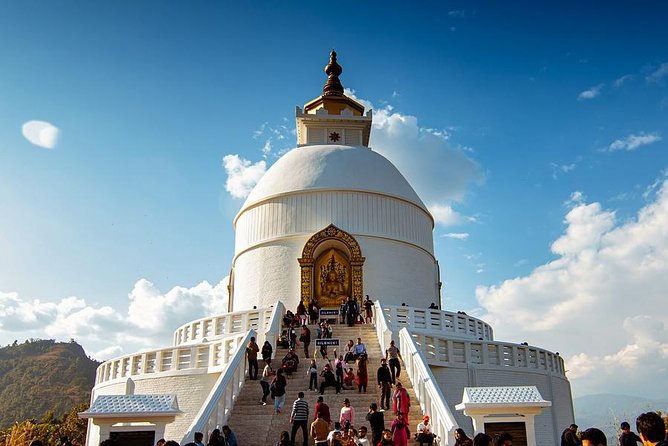
- The World Peace Pagoda, or Shanti Stupa, symbolizes harmony and spirituality, constructed by Japanese monks in Pokhara.
- It represents four significant stages of Buddha’s life: birth, enlightenment, teaching, and nirvana.
- Visitors enjoy breathtaking panoramic views of the Himalayas, Pokhara city, and Fewa Lake from the hilltop.
- Access involves a 30-minute drive from Pokhara and a challenging 10-minute walk up steep staircases.
- Guided tours enhance understanding of the stupa’s significance, offering a tranquil atmosphere for meditation and reflection.
Overview of the Pagoda

Nestled atop a hill overlooking Pokhara, the World Peace Pagoda, also known as Shanti Stupa, stands as a serene symbol of harmony and spirituality.
Constructed by Buddhist monks from the Japanese Nipponzan Myohoji order, it embodies the four significant stages of Buddha’s life: his birth in Lumbini, enlightenment in Bodh Gaya, teaching in Sarnath, and nirvana in Kushinagar.
Visitors can enjoy breathtaking panoramic views of the snow-capped Himalayas, Pokhara city, and Fewa Lake.
A private, personalized sightseeing tour lasts about three hours, including a 10-minute walk through staircases to reach the stupa.
With a perfect 5.0 rating from reviews, this peaceful site invites all who seek to connect with its spiritual essence and stunning surroundings.
You can also read our reviews of more tours and experiences in Pokhara.
Historical Significance
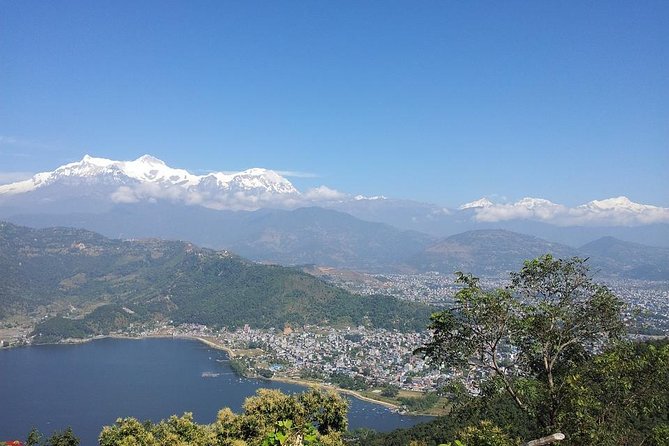
While the World Peace Pagoda is primarily known for its stunning views and spiritual ambiance, its historical significance runs deep. Constructed by Buddhist monks from the Japanese Nipponzan Myohoji order, the stupa symbolizes the teachings of Buddha and promotes peace. Its architecture reflects the four pivotal stages of Buddha’s life, connecting visitors to a rich spiritual heritage.
| Stage | Location | Significance |
|---|---|---|
| Birth | Lumbini | Marks the beginning of Buddha’s journey |
| Enlightenment | Bodh Gaya | Represents the moment of awakening |
| Teaching | Sarnath | Highlights the dissemination of wisdom |
| Nirvana | Kushinagar | Celebrates the attainment of ultimate peace |
This pagoda serves as a reminder of the importance of peace and harmony in our world.
Tour Information
Visitors often find the tour to the World Peace Pagoda in Pokhara both enlightening and enjoyable. This private sightseeing experience lasts approximately three hours, starting with a comfortable drive of about 30 minutes.
Once at the base, guests embark on a 10-minute walk up the staircases to reach the stupa. The tour includes hotel pickup and drop-off within Pokhara, making logistics hassle-free.
Admission tickets are included, but it’s important to note that the site isn’t wheelchair accessible and infants need to sit on laps. Comfortable shoes are recommended due to moderate walking.
With prices starting at $60.00, this personalized tour offers a great value for those looking to explore this iconic monument.
Scenic Views
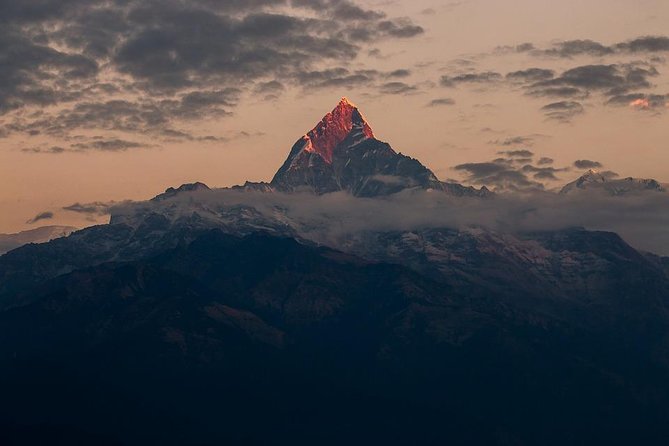
The journey to the World Peace Pagoda culminates in breathtaking panoramic views that captivate every traveler.
Perched atop a hill, the stupa offers sweeping vistas of the majestic snow-capped Himalayas, which create a stunning backdrop for any photo. Visitors can gaze down upon the vibrant city of Pokhara, where colorful buildings and greenery blend harmoniously.
The serene Fewa Lake glistens below, reflecting the beauty of the surrounding landscape. This unique vantage point not only showcases nature’s splendor but also provides a peaceful atmosphere for contemplation.
An informative guide often accompanies guests, sharing insights about the stupa’s significance and the principles of Buddhism in Nepal, enhancing the overall experience of this remarkable location.
Visitor Experience
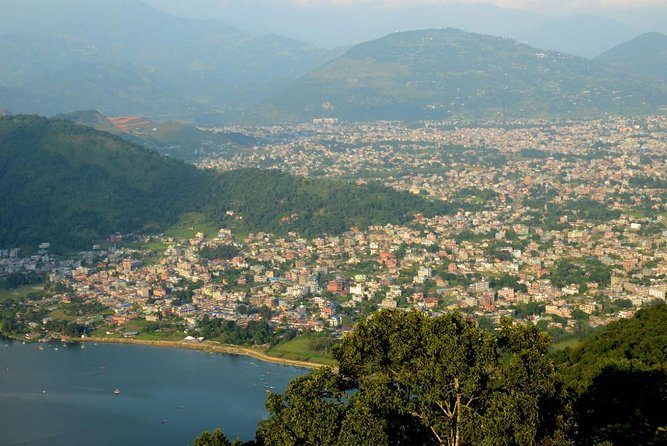
Many travelers leave the World Peace Pagoda with a profound sense of tranquility and enlightenment. The serene atmosphere and stunning surroundings create a memorable experience that resonates long after their visit.
To enhance their time at this spiritual site, visitors often focus on a few key activities:
-
Meditation and Reflection: The peaceful ambiance encourages introspection, making it an ideal spot for meditation.
-
Photography: The breathtaking views of the Himalayas and Fewa Lake provide excellent photo opportunities.
-
Learning: Guided tours offer insights into the significance of the stupa and Buddhism, enriching visitors’ understanding of this cultural landmark.
These elements contribute to an enriching experience, allowing travelers to connect deeply with the essence of the World Peace Pagoda.
Accessibility Details
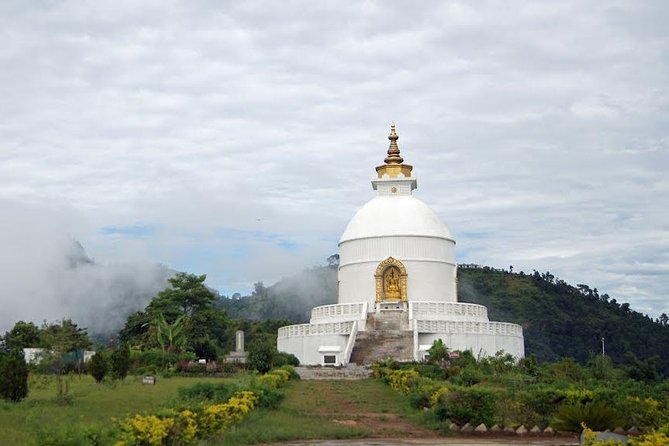
Accessing the World Peace Pagoda presents some challenges, particularly for those with mobility issues.
Visitors must navigate a steep 10-minute walk up staircases after a 30-minute drive from Pokhara. The path can be strenuous, and the absence of wheelchair access makes it less accommodating for individuals requiring assistance.
For families, infants must sit on laps during the journey, adding to the logistical considerations. It’s advisable to wear comfortable shoes to tackle the moderate walking involved.
While the stunning views and serene atmosphere reward those who make the effort, it’s essential for travelers to prepare accordingly.
Those with mobility concerns might want to explore alternative viewing options in the Pokhara area to ensure a more comfortable experience.
Pricing and Booking
Visitors eager to explore the World Peace Pagoda will find pricing and booking details straightforward and transparent. The experience starts at a competitive price of $60.00, which varies depending on group size.
To ensure a smooth booking process, here are three key points to remember:
- Confirmation: You’ll receive booking confirmation immediately, making planning easy.
- Meeting Point: The designated meeting point is Barahi Chouk, Lakeside Rd Chowk, Pokhara 33700, Nepal.
- Pickup Service: A convenient pickup service is available within Pokhara city; just provide the hotel name and address.
With these details in hand, visitors can confidently plan their visit to this stunning stupa and enjoy its serene beauty.
Tips for Visitors
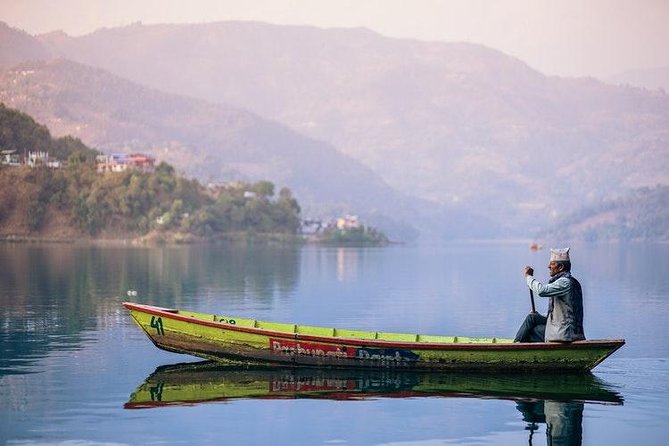
Planning a trip to the World Peace Pagoda can be an enriching experience, and a few practical tips can enhance the visit. Visitors should wear comfortable shoes due to the moderate walking involved. It’s also wise to bring water and snacks to stay refreshed. Early morning or late afternoon visits offer the best lighting for photography and a quieter atmosphere.
Here’s a quick reference table for visitors:
| Tip | Details | Importance |
|---|---|---|
| Arrive Early | Beat the crowds | Enjoy peacefulness |
| Dress Appropriately | Modest clothing is recommended | Respect the site |
| Check the Weather | Plan accordingly | Comfort during visit |
| Bring a Camera | Capture stunning views | Preserve memories |
Following these tips ensures a memorable experience at the pagoda.
Frequently Asked Questions
What Is the Best Time to Visit the World Peace Pagoda?
The best time to visit is during the spring and autumn months. The weather’s mild, and the views are stunning. Early mornings or late afternoons offer the most breathtaking panoramas and a peaceful atmosphere.
Are There Any Nearby Attractions to Explore After Visiting?
After visiting, travelers can explore nearby attractions like Fewa Lake, the International Mountain Museum, or the serene Devi’s Fall. Each offers unique experiences, enriching the journey and showcasing the stunning beauty of the region.
Can I Take Photos Inside the Stupa?
Visitors aren’t allowed to take photos inside the stupa. They respect the sacred atmosphere and encourage quiet reflection. However, outside, stunning views provide excellent opportunities for capturing memorable images of the surroundings.
Is There a Dress Code for Visiting the Pagoda?
Visitors should dress modestly when visiting the pagoda. They’re encouraged to wear clothing that covers shoulders and knees. Respecting local customs enhances the experience, allowing for a more meaningful connection to the sacred site.
Are There Any Local Restaurants Near the Pagoda?
Near the site, visitors can find various local restaurants offering delicious Nepali cuisine. They’ll enjoy authentic dishes while soaking in the vibrant atmosphere, creating a memorable dining experience after exploring the area’s attractions.
The Sum Up
The World Peace Pagoda in Pokhara stands as a beacon of serenity and spirituality, inviting visitors to embrace its peaceful ambiance and stunning views. With its rich history and striking architecture, it’s a must-visit for anyone exploring the region. Whether you’re seeking reflection or simply wish to soak in the breathtaking scenery, this monument offers an unforgettable experience. By planning ahead and following the tips provided, travelers can fully enjoy the beauty and tranquility of this remarkable site.
More Tour Reviews in Pokhara
- Pokhara: 3-Day Ghorephani and Poon Hill Private Trek
- Pokhara: Airport Transfer by Private Car
- From Pokhara: Kori Danda Trek with Sikles Village Stay
- Pokhara: Horseback Riding Adventure with Hotel Pickup
- From Pokhara: 4-Day Ghorepani Poon Hill Trek with Guide
- Pokhara: Annapurna Day Hike with Panoramic Views
Not for you? Here's more nearby things to do in Pokhara we have reviewed
- Pokhara: 3-Day Ghorephani and Poon Hill Private Trek
- Pokhara: Airport Transfer by Private Car
- From Pokhara: Kori Danda Trek with Sikles Village Stay
- Pokhara: Horseback Riding Adventure with Hotel Pickup
- From Pokhara: 4-Day Ghorepani Poon Hill Trek with Guide
- Pokhara: Annapurna Day Hike with Panoramic Views
- Ghorepani Poon Hill Classic 4-Day Trekking Experience
- From Pokhara: 5-Day Annapurna Trek with Hidden Lake
- Pokhara: 4-Day Mardi Himal Trek
- Tibetan Cultural Day Tour Pokhara 2025/2026
- Unforgettable Memories: best view points and Soak in Pokhara
- Luminous Sarangkot: A Breathtaking View of the Himalayas”
